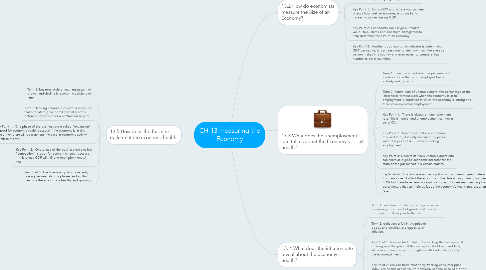CH 13 measuring the Economy
by Michael Sullivan

1. 13.2 How do economists measure the Size of an Economy?
1.1. Key points 1-3 Terms 1 & 2 image
1.2. Term 1: net exports: the value of all exports minus all imports.
1.3. Term 2: gross domestic product: the market value of all final goods and services produced within a country during a given period of time
1.4. Key Point 1: Using GDP and its rate you can see directly how well an economy is doing by its increasing or decreasing GDP.
1.5. Key Point 2: Economists can assign a "market value" to all items and add them all together to help determine the size of an economy.
1.5.1. Key Point 3:
1.6. Key Point 3: Another good economic indicator is determining GDP per capita, it is an easy way to see how much the average person makes in a country and even easier to compare that number to other countries.
2. 13.3 What does the unemployment rate tell us about the Economy's health?
2.1. Term 1: unemployment rate: the percentage of the labor force that is not employed but is actively seeking work
2.2. Term 2: natural rate of unemployment: the percentage of the labor force without work when the economy is at full employment; a condition in which the economy is strong and there is no cyclical unemployment
2.3. Key Point 1: There is always an unemployment rate, this is natural and unemployment can never be at 0%.
2.4. Key Point 2: Unemployment is a commonly misused term, it is only measured by people without a job that ARE actively seeking employment.
2.5. Key Point 3: Despite its flaws unemployment rate can serve as a good economic indicator for the state of the job market in a certain country.
2.6. Explanation: This article is explaining how a low unemployment rate effects or in this case doesn't affect the economy in the desired way. Unemployment is at 5.1% but there have been no significant payroll increases, meaning there are other factors that can help us judge the economy's health not just unemployment rate.
3. 13. 4 What does the inflation rate reveal about the economy's health?
3.1. Term 1: inflation rate: the percentage increase in the average price level of goods and services from one month or year to the next.
3.2. Term 2: deflation: a fall in the price of goods and services; the opposite of inflation.
3.3. Key Point 1: You can track inflation by tracking the average cost of living over the years. If the average cost of living suddenly shifts or in general is just too high then this will reflect poorly on the economy's health.
3.4. Key Point 2: You can track inflation by tracking consumer price index. Doing this allows you to physically see the price of a good rise or fall over the years. If the good drastically increases in a shortish period of time then this reflects badly on the economy's health.
3.5. Key Point 3: Not all inflation is a reason to panic, some inflation is natural in most economies, this is called creeping inflation and it steadily increases year after year but does not reflect the condition of the economy's health.
4. 13.5 How does the Business cycle relate to economic health.
4.1. Term 1: business cycle a recurring pattern of growth and decline in economic activity over time
4.2. Term 2: leading economic indicators measures that consistently rise or fall several months before an expansion or a contraction begins
4.3. Key Point 1: One phase of the business cycle called "expansion" is good for economic health because if the economy is in this phase then there will be a general increase in economic activity month to month.
4.4. Key Point 2: One phase of the business cycle called "contraction" is poor for economic health because in this phase GDP will fall and unemployment will rise.
4.5. Key Point 3: The business cycle is constantly flowing between its four phases and all that means is the economy is healthy and growing.


